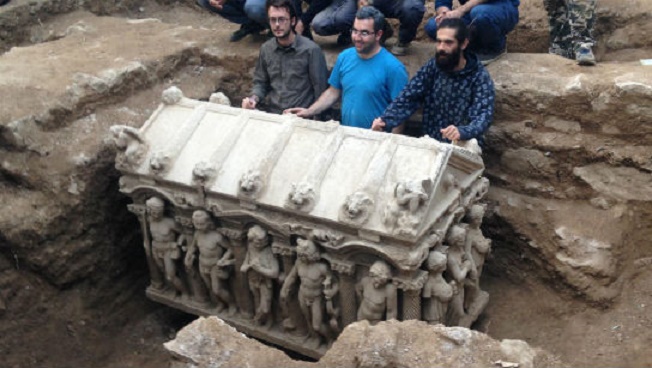|
A wee plug here. The upcoming 2017 Annual Meeting of the Archaeological Institute of America — convening this January 5-8 in Toronto — features an organized session devoted entirely to Roman sarcophagi. With six papers and two respondents (among them Ortwin Dally, Director of the DAI-Rome), it offers a full lineup of sarcophagine (sarcophagal? sarcophagoidal?) delight.
Session 6I: New Research on Roman Sarcophagi: Eastern, Western, Christian Saturday, Jan. 7, 1:45 - 4:45 pm Chairs: Sarah Madole (CUNY—BMCC) and Mont Allen (Southern Illinois University) (1) "Sarcophagus Studies: The State of the Field (as I see it)" Bjoern C. Ewald (Universit of Toronto) (2) "Roman Sarcophagi from Dokimeion in Asia Minor: Conceptual Differences between Rome and Athens" Esen Öğüş (Ludwig-Maximilians-Universität, Munich) (3) "A New Mythological Sarcophagus at Aphrodisias" Heather N. Turnbow (The Catholic University of America) (4) "Beyond Grief: A Mother's Tears and Representations of Semele and Niobe on Roman Sarcophagi" Sarah Madole (CUNY—BMCC) (5) "Strutting Your Stuff: Finger Struts on Roman Sarcophagi" Mont Allen (Southern Illinois University) (6) "Love and Death: Jonah as Endymion in Early Christian Art" Robert Couzin (independent scholar) (7) Response Christopher H. Hallett (U.C. Berkeley) (8) Response Ortwin Dally (Deutsches Archäologisches Institut) Istanbul's Daily Sabah reports that yet another Roman sarcophagus has been discovered in Turkey's Hisardere district, five kilometers northeast of İznik, less than a year after the discovery of this piece in the same district.
The İznik Museum, it is related, plans to put the specimen on display. As originally reported by Today's Zaman (no longer available) and reposted by News Network: Archaeology: in November of last year a Roman sarcophagus was unearthed by a farmer in the Hisardere area of Turkey, northeast of İznik.
The format of the coffin seems typical of those from Docimium/Dokimeion; but Esen Öğüş, a colleague more familiar with eastern sarcophagi than I, tells me she thinks it is actually a local product carved in imitation of the expensive Docimean pieces. She intends to publish the finding. As reported by the Tribune de Genève — and later covered in greater detail by the Tages-Anzeiger (many thanks to Christian Russenberger for the link) — a Swiss public prosecutor has ordered that a Roman sarcophagus deposited in the Geneva Freeport warehouse in 2010 and subsequently seized by Swiss Customs during an inventory check later that year be returned to Turkey. The piece itself is exquisite: a creamy Docimean specimen, likely Antonine in date, showing the Twelve Labors of Hercules. As detailed in earlier blog posts (here, here, and here), Metropolitan sarcophagi (i.e., those from the city of Rome itself) devoted to the Labors of Hercules typically array the hero's first ten labors on the front of the chest in narrative order, with the eleventh and twelfth depicted on the short ends, and nothing on the back (as usual for Metropolitan works), This piece, in contrast, strews the vignettes around all four sides — as expected for an eastern product — in no discernable order. |
Roman
|




